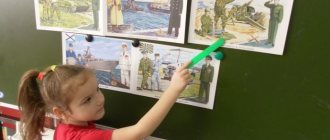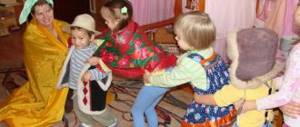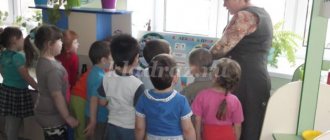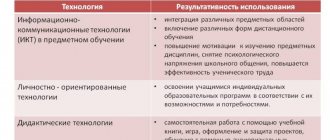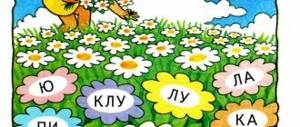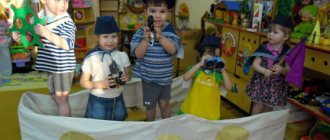Long-term plan for the national-regional component in the middle group
Lyubov Maskova
Long-term plan for the national-regional component in the middle group
Municipal budgetary preschool educational institution
"Zarinsky kindergarten "Sun"
Forward planning
according to national-regional
component
in the middle group
Educator: Maskova Lyubov Rakhmanovna
2017-2018
Long-term plan for the national-regional component in
middle group “Why”
Month Week Contents Tasks
September 2nd 1. Conversation: “Where do we live?”
— Expand children’s ideas about the house, yard, village where they live;
-form an idea of your small homeland;
-continue to develop knowledge about street names and cultural sites; - cultivate love for your native village, the place where you were born
4th 2. Reading fiction: “Our address is not a house or a street”
- to form in the child the idea that not only humans have a home.
October 2nd 1. Introduce the work of the Altai artist Grigory Ivanovich Choros-Gurkin (examination of reproductions of paintings)
-Help children experience the beauty of their native Altai nature, artist Grigory Ivanovich Choros-Gurkin
4th 2. Conversation on the painting by Sergei Anatolyevich Prokhorov “Birch Motif”, “Falling Leaves”
-Introduce the artist of the Altai region S. A. Prokhorov. - accumulate artistic and aesthetic impressions of children.
November 2nd 1. Joint sports entertainment “The most athletic family”
-Involve families in a healthy lifestyle; - to cultivate respect for one’s health and interest in physical education in joint sports activities.
4th 2. “Conversation about mother” -Give ideas about the importance of each person’s mother; -help children understand how much time and effort a mother takes from housework: point out the need for help for mothers. - formation of valuable moral skills (love, empathy, etc.).
December 2-a 1. What is good about winter? Winter games are fun.
-Involve children in winter folk games; -encourage children to talk about where they walked and what they did.
4th 2. Exhibition of children's works “Our Christmas tree is simply a miracle.”
January 2nd 1. Animals of the Altai Territory. (presentation)
-To form children’s knowledge about animals and birds that live in the forests of our region.
4th 2. Birds of the Altai region. (look at illustrations)
February 2nd 1. Conversation about household items. (examination of illustrations of household items)
-To form an idea of household items in a Russian hut; - to cultivate a sustainable interest and respect for the history and culture of the Russian people;
-acquaintance with household items – a spinning wheel and a spindle.”
4th 2. Folklore holidays, conversations, listening to folk music, getting to know folk instruments - Creating a favorable atmosphere, love, joyful mood. To develop children's interest in traditions and customs
March 2nd 1. “Medicinal herbs of the Altai region”
(presentation) -Introduce children to a variety of medicinal herbs of the Altai region, -form ideas about the role of plants in improving and maintaining human health.
4th 2. Spring in the kindergarten area (walk)
.
-Talk about changes in nature in spring, signs of spring.
April 2nd 1. Examination of the photo album “Nature of the native land” -
Teach children to see the beauty of their native nature - to cultivate love for their small Motherland.
4th 2. “Various types of historical crafts and crafts in the Altai Territory (teacher’s story, see illustrations)
To acquaint children with the work of our ancestors, expand children's knowledge about folk crafts, cultivate respect for work and people at work
May 2nd 1. Famous people of the Altai Territory (presentation). -Introduce children to fellow countrymen - famous people of Russia; - to make you proud of your fellow countrymen.
4th 2. Introduction to the fairy tale “The Earth Sings”
-To foster moral and patriotic qualities, respect for warrior-defenders
Summary of educational activities for speech development using the regional component for the younger group
Summary of educational activities for speech development using the regional component for young children “Guests from the Fun Train”
Author: Nadezhda Nikolaevna Panova, teacher of the Irdanovsky kindergarten “Kolosok”, Nikolsky district, Vologda region. Description of the material: this course is designed for children of primary preschool age and is taught in a playful way. Objectives: To teach understanding of speech by organizing a situation with toys. To develop active speech in children, encouraging speech manifestations. Develop attention and visual-effective thinking, encouraging participation in joint games. (cause a desire to imitate, repeat actions) Expand children's ideas about wild animals of their region (hedgehog, hare, bear) Form a feeling of love for all living things Expand their active vocabulary (fluffy, soft, prickly, hedgehog, hedgehog, hedgehog) Encourage children to use the name of their village or kindergarten in their speech. Equipment: toys (bear, hedgehog, bunny) Pictures (fungus, cone, nut, spruce twig, acorn, pine branch) Train from a large construction set, Pictures (hedgehog, hedgehog, hedgehogs) Apples and mushrooms (silhouettes) Honey gingerbread, carrots, candies.
Little bell. Progress:
Educator: Guys, look what we have in our group? Children: This is a steam locomotive (choral and individual answers) Educator: Do you want to know who came to us on this locomotive? Then sit on the chairs and watch. A little train came to us from a distant forest and brought funny animals. Animals live in a beautiful big forest, and you live in a village. What is the name of the village where you live? Children: I live in the village of Irdanovo. In the village of Abboturovo. Educator: You all go to kindergarten, but what is it called? Children: Kindergarten "Spikelet" Educator: Who is sitting in the first car? Children: This is Hedgehog. (The teacher speaks on behalf of the hedgehog) Hello, guys! Are you guys kittens? Children: No. Are you guys rabbits? Children: No. Are you guys foxes? Children: No. Who are you? Educator: Let's tell the hedgehog that we are not squirrels or bunnies, but we are girls and boys! (they say it together) Then tell me what your name is. (children say their names). Well, we met. Educator: No (addressing the hedgehog) they don’t introduce themselves like that, you found out our names and who we are, but you didn’t introduce yourself. Who are you? Hedgehog: I'm a hedgehog, I live in the forest. I have a prickly back and a soft tummy. I look with my eyes, I smell with my nose, and I have four legs, they help me run along forest paths. I also brought you photographs of my family. (Showing photographs) Educator: What a friendly family the hedgehog has. What should we call the father of this family? Children: hedgehog. Educator: And kindly? Children: Hedgehog. Educator: What should we call mom? Children: Hedgehog. Educator: What should we call the children? Children: Hedgehogs. Educator: The hedgehog is very glad that he came to visit you, let's treat him with mushrooms and apples. (children treat the hedgehog) Educator: Let's see who else came to visit us. Bear: I'm a naughty bear. I live in the forest with my mom and dad, under a big pine tree. And I brought you guys some gifts from the forest Educator: Let's see what's in the basket. (pictures: fungus, cone, nut, spruce twig, acorn) We, bear, want to play with you. Game “Once we were walking in the forest”
Once we were walking in the forest And we saw a bear.
He lies under the tree, stretched out and snoring. We walked around him and woke him up. Come on, little darling, get up and quickly catch up with us. Educator: The bear didn’t catch anyone. Don’t be upset, bear, hold the honey gingerbread, and the guys will recite a poem to make you laugh. A clubfooted bear walks through the forest, collects cones and puts them in his pocket. The cone flew off, right into the bear's forehead. The bear got angry and kicked it, stomping. The bear loves sweet honey. The bear takes honey from the bees. He is also famous for sleeping soundly in winter. Educator: Well done, guys, the bear really liked your poems. Who else came on the fun train? Yes, this is a cowardly bunny. He is afraid of everything, but wants to make friends with you. Let's pet him and say "Good bunny." Look at his ears? Children: Big, long. Educator: What about the tail? Children: Small, fluffy. Educator: Bunny, do you like to play? Bunny: Of course I do. Game “The little white bunny is sitting” Educator: How fun we played, let’s treat the bunny with a carrot. Bunny: Thank you. Educator: Guys, what’s in the last car? Let's say, “Locomotive, locomotive, what did you bring us as a gift?” (Choral and individual answers) Educator: Yes, these are the forest animals who brought us gifts (apples and candies). Let's say goodbye to our guests and tell them a good journey. I have a magic bell that we will play with during our walk.
We recommend watching:
Summary of educational activities for speech development in the 2nd junior group. Forest walk Notes on the development of speech in the first junior group on the topic: Spring Notes on an integrated lesson on speech development in the second junior group Notes on the development of speech in the junior group on speech development
Similar articles:
Lesson notes on speech development in the second junior group
Implementation of the regional component in the second younger group for children 3–4 years old
Nadezhda Shimko
Implementation of the regional component in the second younger group for children 3–4 years old
Implementation of the regional component.
Implementing the Model Basic Educational Program “Rainbow”
, this section of the work program will help the teacher in forming the timely and complete mental development of each child, laying the foundations of personality:
1.lay the foundation of self-image:
A. enrich the child’s self-image with ideas about his past and present;
b. to develop the ability to distinguish between attitudes towards oneself and criticism of the products of one’s activities;
V. develop confidence in yourself and your capabilities; develop activity, initiative, independence
To do this you need:
• tell each child about how little he was and what he has become now;
• tell children about their real and possible future achievements;
• celebrate and publicly support any successes of children ;
• encourage children's and expand its scope;
• support the desire to learn how to do something and the joyful feeling of increasing skill;
• in different forms of work, be tolerant of the child’s difficulties, allow him to act at his own pace;
• take into account the individual characteristics of children , strive to find an approach to shy, indecisive, conflict-ridden, unpopular children;
• do not directly criticize the results of children’s , as well as themselves;
• use only game characters for whom children's activity products were created as carriers of criticism;
• limit criticism solely to the results of the child’s productive activities
• respect and value every child, regardless of his achievements, strengths and weaknesses;
2.promote the formation of socially valuable relationships with peers:
A. form friendly and equal relationships between peers;
b. prevent negative behavior and introduce ways to resolve conflicts;
V. form ideas about positive and negative actions;
d. introduce clear standards for group , prohibit the use of violence to resolve conflicts, destroy the products of the activities of other children , and use the personal belongings of others without their consent;
e. create a positive psychological microclimate in the group , equally showing love and care for all children: express joy when meeting; use affection and warm words to express your attitude towards the child; respect the individual tastes and habits of children .
To do this you need:
• maintain the tradition of briefly telling the whole group something positive about each child;
• involve children in taking turns completing short, attractive tasks;
• establish together with children the causes of conflicts, involve children in finding their solutions ;
• help children when their interests clash regarding toys;
• form ideas about positive and negative actions;
• organize collective approval/condemnation of impersonal, understandable to children, good and bad actions in the form of a game, puppet theater;
3.form relationships with adults from your immediate environment:
A. strengthen trust and attachment to an adult;
b. develop interest in him as a partner in joint activities, capable of teaching new ways of doing things.
To do this you need:
• create a positive psychological microclimate in the group , equally showing care and love for all children;
• express joy when meeting a child when he comes to the group ;
• use affection and warm words to express your attitude towards the child;
• show delicacy and tact when identifying the needs and requirements of the child, help him get out of difficult and degrading situations (isolate him from other children when changing dirty linen, cheer him up, calm him down);
• provide all children with equal opportunities when using toys, equipment, and materials;
• respect the individual tastes and habits of children ;
• act as a partner and organize joint work, constructive, and play activities with children individually and in subgroups ;
4.form an attitude towards the world around you:
A. overcome manifestations of cruelty towards living beings;
b. lay the foundations for a careful and caring attitude towards the world around us;
V. maintain a creative attitude towards the world around us and a willingness to make labor efforts;
d. maintain cognitive interest in the world.
To do this you need:
• begin to form an individuality in the field of cognitive interests and preferences;
• show an example of caring for nature and other people;
• practice showing respect for objects and an attentive, caring attitude towards people around you (playing out “problems”
toys related to everyday situations and behavioral problems);
• introduce the tradition of “We fix it - we help”
, hold
group mini-holidays with hand-made objects and materials (soap bubbles, paper candy wrappers, etc.)
;
• evoke an emotional response to various objects and natural phenomena during direct communication with them (observations, excursions, walks)
;
• involve children in caring for plants; hold mini-holidays with natural materials (cones, water, snow, sand, etc.)
;
• form the position of an assistant and protector in relation to natural objects.
Preschool childhood is the main and important stage when the foundations of personal development are laid. This is the period when a child begins to realize himself and his place in this world, when he learns to communicate, interact with other children and with adults. I decided to start working in this direction by introducing children to their immediate environment.
Target.
To educate a worthy citizen and patriot who knows and loves his land, the village where he was born and lives.
Tasks.
*Give an initial idea of the nature of the Rostov region, introduce some plants of the Rostov region.
*Introduce birds and animals of the area.
*Introduce the name of your native village, cultivate love for it: introduce some street names, talk about its beautiful places, attractions, introduce the creativity of talented people of the Rostov region.
Month
Form of work Objectives
September 1. Conversation on the topic: “What is a kindergarten?”
2. Conversation on the topic: “Village street”
.
3. Listening to songs about your native land.
4. Construction of “Village Street”
. 1. Cultivate in children a friendly attitude towards each other, a desire to play together, communicate, and be friends.
2. Give the concept that each street in the village has its own name, give the concept of “address”
.
3. Cultivate love for your native land, the place where you were born.
4. Encourage interest in design, introduce the name of your street.
October 1. Examination of illustrations on the theme: “Golden Autumn”
.
2. Conversation on the topic: “My favorite village
.
3. Learning nursery rhymes “Water-Water”
,
"Grow, braid, to the waist"
.
4. Game “Who works where?”
.
1. To develop children interest in their native nature and its beauty.
2. Learn to name the village in which the children live.
3. Introduce folklore.
4. Talk about the professions of people in their native village, their place of work.
November 1. Autumn at the kindergarten site (walk)
.
2. Drawing on the theme: “My autumn street”
.
3. Examination of illustrations, photographs of patterns in the painting of huts.
4. Conversation with children on the topic: “My address”
.
1. To form in children an idea of autumn as a time of year, to focus on the beauty and diversity of their native nature
2. To foster interest in folk life and products of decorative and applied arts.
3. Teach children to remember their home address.
December 1. Learning nursery rhymes “Cat-Cat”
,
“Murka the Cat”
,
“Magpie-Crow”
.
2. Acquaintance with folk musical instruments.
3. Reading the Russian folk tale “Kolobok”
.
1. Accustom children to listening to folk nursery rhymes.
2. Introduce children to Russian folk instruments and create a desire to play the instruments.
3. Introduce children to Russian folk tales and develop an interest in books.
4. Introduce children to the sights of the village.
January 1. Winter on the kindergarten site (walk)
.
2. Puppet show “Turnip”
.
1. Introduce children to the first signs of winter.
2. Continue to introduce children to Russian folklore.
February 1. Winter in my native village.
2. Joint drawing of parents and children on the topic : “The house where I live”
.
3. Getting to know the Russian folk game “Zhmurki”
.
4. We are drawing a fairy tale. 1. Expand ideas about winter natural phenomena, human adaptability to life in winter.
2Consolidate knowledge of your home address, cultivate love for your home, street, village.
3. Introduce children to folk games , help children understand the characteristics of people’s national culture through play.
4. Develop interest in Russian folk tales and drawing.
March 1. “Maslenitsa”
2. Learning the Russian folk game “Rucheyok”
.
1. Cultivate in children an interest in Russian folklore, memorizing nursery rhymes, proverbs, and sayings.
2. Continue to introduce Russian folk games, cultivate a desire to play games
April 1. Listening to Russian folk songs. 2. Transport of the native village.
3. Examination of products with embroidery “The Tradition of My Great-Grandmother”
4. Reading folk proverbs and sayings 1. Continue introducing Russian folk art.
2. Learn to distinguish between types of transport, form an idea of what a small homeland is.
3. Introduce children to types of handicrafts and cultivate love for their people.
4. To foster children’s to learn about the culture of their country through proverbs and sayings
May 1. Spring in the kindergarten area (walk)
.
2. Seasons. 1. Talk about changes in nature in spring, signs of spring.
2. Consolidate and generalize children’s knowledge about the seasons .
The regional component is implemented in integration with all types of activities of preschool children: in routine moments, joint free activities of children in accordance with thematic planning.
For this work, I use a methodological manual for educators, O. L. Knyazev, M. D. Makhanev “Introducing children to the origins of Russian folk culture”
, St. Petersburg, 2008
